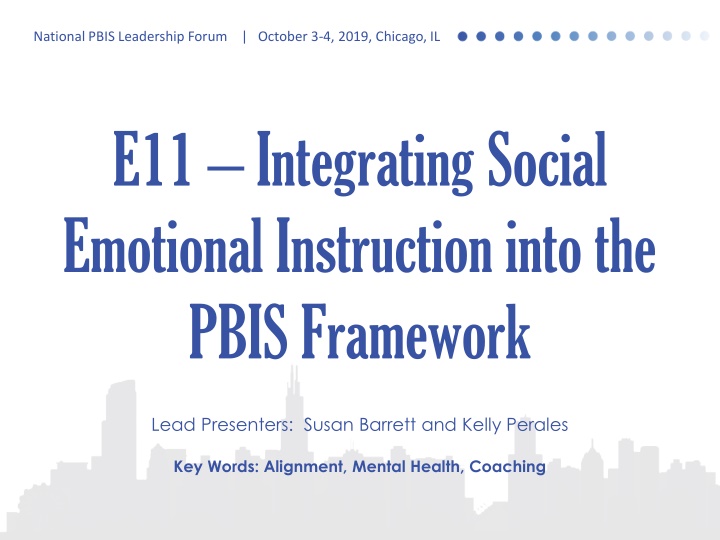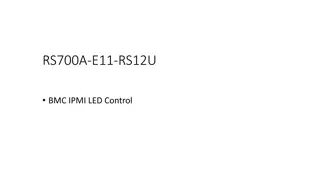
Integrating Social-Emotional Instruction into PBIS Framework - Forum Highlights
Explore key insights and strategies shared at the National PBIS Leadership Forum regarding the alignment of social-emotional learning within the PBIS framework. Learn ways to enhance mental health support and coaching in educational settings for improved outcomes.
Download Presentation

Please find below an Image/Link to download the presentation.
The content on the website is provided AS IS for your information and personal use only. It may not be sold, licensed, or shared on other websites without obtaining consent from the author. If you encounter any issues during the download, it is possible that the publisher has removed the file from their server.
You are allowed to download the files provided on this website for personal or commercial use, subject to the condition that they are used lawfully. All files are the property of their respective owners.
The content on the website is provided AS IS for your information and personal use only. It may not be sold, licensed, or shared on other websites without obtaining consent from the author.
E N D
Presentation Transcript
National PBIS Leadership Forum | October 3-4, 2019, Chicago, IL E11 Integrating Social Emotional Instruction into the PBIS Framework Lead Presenters: Susan Barrett and Kelly Perales Key Words: Alignment, Mental Health, Coaching
Objectives Define SEL and PBIS Describe how to align SEL within the PBIS framework Learn strategies for replicating at the district and building level
A Technical Brief Available at www.pbis.org Teaching Social-Emotional Competencies within a PBIS Framework Barrett, S., Eber, L., McIntosh, K, Perales, K., Romer, N., April, 2018
Teaching Social Teaching Social- -Emotional Competencies Emotional Competencies within a PBIS Framework within a PBIS Framework Describe how school personnel can teach social- emotional competencies within a PBIS framework to support systematic, school-wide implementation through one system, rather than trying to improve student outcomes through separate, competing initiatives. Recommendations for how to adjust the PBIS framework to support instruction of social emotional competencies are included. Barrett, S., Eber, L., McIntosh, K, Perales, K., Romer, N., April, 20
Current Status: Impact to Society Current Status: Impact to Society Suicide 2nd leading cause of death among teens in USA (June 2016) One in 5 youth have a MH condition that impacts social and academic success (5 million children and youth) About 80% of those get no treatment School is defacto MH provider Of those that do 75% receive services in schools JJ system is next level of system default more than 600,000 youth annually are placed in detention centers with mental health disorders 3X rate of general population.
Current Data Trends Current Data Trends Opioid crisis (NIH) Suicide rates (NAMI) Students with internalizing behaviors (NAMI) Impact of social media, weather events
Equal Priority for Social and Emotional Competencies ESSA- non academic indicators School Climate Transformation Grants Project AWARE Whole Child Initiatives College and Career Readiness Prevention Science Impact of Nurturing Environments
Big Idea: Mental Health is Big Idea: Mental Health is EVERYONE S JOB EVERYONE S JOB From parents to principals to teachers to the lunch staff : Everyone helps create a safe, caring environment. A place where mental health problems aren t stigmatized. Everyone watches for warning signs in a child such as changes in mood, headaches, slipping grades and missing class. Social Emotional Behavioral Competencies are embedded in ALL aspects of the curriculum and use of those skills are monitored by ALL STAFF
Social Emotional Learning Social Emotional Learning the process through which children and adults acquire and effectively apply the knowledge, attitudes, and skills necessary to understand and manage emotions, set and achieve positive goals, feel and show empathy for others, establish and maintain positive relationships, and make responsible decisions (CASEL, 2017).
Teaching Teaching Social within a PBIS Framework within a PBIS Framework Social- -Emotional Competencies Emotional Competencies Increasingly, researchers have recommended teaching social-emotional competencies within a prevention-focused, multi-tiered public health framework, because simply adopting a curriculum does not lead to adequate implementation or improved outcomes (Greenberg, Domitrovich, Weissberg, & Durlak, 2018; Merrell & Gueldner, 2010). Barrett, S., Eber, L., McIntosh, K, Perales, K., Romer, N., April, 2018
Teaching Social-Emotional Competencies within a PBIS Framework PBIS provides the necessary system to facilitate implementation of social-emotional competencies within a framework for improving student outcomes for the whole child. Barrett, S., Eber, L., McIntosh, K, Perales, K., Romer, N., April, 20
PBIS PBIS Multi-tiered framework for implementing evidence-based practices informed by implementation science (Horner, Sugai, & Fixsen, 2016).
PBIS teaming, data, training/coaching systems explicit teaching of positively-stated behavior expectations across school settings.
The PBIS Framework (a) a prevention-focused continuum of supports, (b) data-based decision-making, (c)regular universal screening and progress monitoring, (d) systems change through ongoing professional development and coaching, (e) team-based leadership, and (f)evidence-based practices for improving behavior and learning Horner, Sugai, & Anderson, 2010
Documented Effect of PBIS Documented Effect of PBIS Implementation Implementation Student Outcomes decreased problem behavior and bullying and increased emotional regulation and perceived school climate), Adult outcomes decreased burnout and improved organizational health Bradshaw, Waasdorp, & Leaf, 2012; Horner, Sugai, & Anderson, 2010; Kelm & McIntosh, 2014; Waasdorp, Bradshaw, & Leaf, 2012).
PBIS teaching has expanded to a PBIS teaching has expanded to a broader range of desired student broader range of desired student behaviors: behaviors: social skills, emotional regulation, problem solving, and coping strategies Instruction used to address internalizing mental health concerns (e.g., anxiety, depression;)
Need to Deliberately Integrate: Need to Deliberately Integrate: Despite these advances, school teams implementing PBIS sometimes overlook teaching important social-emotional competencies or view this domain as separate from their PBIS framework. Instead of integrating social and emotional competency instruction within their PBIS framework, schools may implement a packaged social and emotional learning curriculum that is not connected to other behavior support systems in the school.
Use of PBIS Framework Use of PBIS Framework Skills taught are selected based on student need (data) Impact of teaching is measured though predetermined assessment (data) Instruction is adapted based on data (continuous improvement) This decision-making is done through representative teams
Which statement reflects your team(s) Which statement reflects your team(s) use of SEB Instruction and PBIS? use of SEB Instruction and PBIS? Our PBIS team is already using social skills, SEL or life skills curriculum. Our PBIS team is looking at potential SEL curriculum. Our PBIS team has not yet considered aligning SEL curriculum.
Big Idea: Aligned Approaches Big Idea: Aligned Approaches We may be underutilizing initiatives if we aren t considering how they work together. PBIS is the mechanism to install evidence based practices. Core Features- team based, continuous data based problem solving, fidelity and impact checks, layered and connected to core curriculum, opportunities to demonstrate, show and get feedback What is guided by needs of children and youth How is guided by PBIS core features
ISF Defined ISF Defined Structure and process for education and mental health systems to interact in most effective and efficient way. Guided by key stakeholders in education and mental health/community systems Who have the authority to reallocate resources, change role and function of staff, and change policy.
ISF Enhances MTSS Core Features Effective teams that include community mental health providers Data-based decision making that include school data beyond ODRs and community data Formal processes for the selection & implementation of evidence- based practices (EBP) across tiers with team decision making Early access through use of comprehensive screening, which includes internalizing and externalizing needs Rigorous progress-monitoring for both fidelity & effectiveness of all interventions regardless of who delivers Ongoing coaching at both the systems & practices level for both school and community employed professionals
1. Single System of Delivery Key Messages 3. Mental Health is for ALL 4. MTSS essential to install SMH
Recommendations for Teaching Recommendations for Teaching Social/Emotional Competencies Social/Emotional Competencies Through PBIS Through PBIS 1. Implement Social/Emotional/Behavior Support through a single Team; 2. Expand the Data that Teams Use to Identify Which Skills to Teach 3. Promote Adult Wellness by Creating a Nurturing Staff Environment 4. Teach Social/Emotional Competencies Using the PBIS Instructional Systems;
District support to Building District support to Building Teams Teams Provide resources to coordinate and implement an expanded approach by providing time, training, and support for ALL staff to model, teach, and reinforce social-emotional competencies in students. Provide explicit statements that teaching social- emotional and behavior competencies is central to instruction and embedded in all aspects of the curriculum.
Expanded Use of Expanded Use of Data School, Family , Community School, Family , Community Data: : Academic (Benchmark, GPA, Credit accrual etc) Discipline Attendance Climate/Perce ption Visits to Nurse, Social Worker, Counselor, etc Screening (teacher; family; youth view) Community Demographics Food Pantry Visits Families members deployed Families impacted by drug use, domestic violence Calls to crisis centers, hotlines, hospital visits Screening at multiple views
Develop Develop Systems for Supporting Systems for Supporting Adults Implementing Adults Implementing SEB Instruction within PBIS Framework within PBIS Framework Instructional approach Use data to get buy in and continuous improvement Showcase effort and impact PD should be team led, data- driven with coaching SEB Instruction
Alignment of SEB Instruction and PBIS From small number of staff delivering lessons to ALL staff providing opportunities to teach in ALL settings, ALL day
How?... How?... The Same Process for teaching Social Emotional The Same Process for teaching Social Emotional Behavior as used for Academics Behavior as used for Academics DEFINE (TELL) Simplify ADJUST (RETEACH) For efficiency MODEL (SHOW) BE CONSISTENT PRACTICE In setting MONITOR
Specific Behaviors + Social Specific Behaviors + Social- -Emotional Skills Emotional Skills Specific Behavior or Social Emotional Skill Expectation Keep hands and feet to self Be Safe I tell an adult when I am worried about a friend. Use the signal to ask a public or private question. Be Respectful Make sure everyone gets a turn. Turn in all work on time Be Responsible Check in with my feelings during the day
Specific Behaviors + Pro Specific Behaviors + Pro- -Social Skills Social Skills Specific Behaviors Throw paper in the waste can Use the right side of the stairway Bring all materials to class Keep hands, feet, and other objects to yourself Pro-Social Skills Choose kindness over being right; pick up trash even if it isn t yours Encourage others; tell peer they did a good job
Customize to fit your student and staff Customize to fit your student and staff needs needs Staff, students and families customize to fit need. Prioritize skills If large number of students displaying problem behavior or experiencing stress Identify lessons within curriculum Identify key strategies and skills Add to matrix- common script used across day and content areas to provide opportunities to practice Used as prompt and script for adults to model, prompt/pre-correct, re-teach, provide feedback
Support staff considering the cafeteria as a place to embed services in the natural context Teaching how to socialize in the cafeteria Teaching healthy eating habits Team approach that involves admin, teachers, caf supervisors, food service personnel, students and families
INCORPORATE Coping Strategies for Managing Stress Teaching Matrix Library/ Comput er Lab All Playground s Assembl y Lunch Halls Bus Settings Be on task. Give your best effort. Be prepared. Invite those sitting alone to join in Study, read, compute. Sit in one spot. Watch for your stop. Respectful Walk. Have a plan. Have a lunch plan and choose quiet or social lunch area Share equipment. Include others. Expectations Use normal voice volume. Walk to right. Be kind. Hands/feet to self. Help/share with others. Listen/watc h. Use appropriate applause. Use a quiet voice. Stay in your seat. Achieving & Organized Whisper. Return books. Invite friends to join me Use my breathing technique Pick up litter. Maintain physical space. Push in chairs. Treat books carefully. Use equipment properly. Put litter in garbage can. Recycle. Clean up after self. Pick up. Treat chairs carefully. Responsibl e Wipe your feet. Listen to my signals
For other schools, may be a social media concern . INCORPORATE Strategies for Using Technology Teaching Matrix Library/ Comput er Lab All Technology Halls Playgrounds Assembly Bus Settings Be on task. Give your best effort. Be prepared. Words matter, pause and reflect before you post Study, read, compute. Sit in one spot. Watch for your stop. Respectful Expectations Walk. Have a plan. Check your feelings Re-read message Share equipment. Include others. Be kind. Hands/feet to self. Help/share with others. Use normal voice volume. Walk to right. Listen/watc h. Use appropriate applause. Use a quiet voice. Stay in your seat. Achieving & Organized Whisper. Return books. Model for others double check sources and consider feelings of others Pick up litter. Maintai n physical space. Use Push in chairs. Treat books carefully. Pick up. Treat chairs carefully. Recycle. Clean up after self. equipment properly. Put litter in garbage can. Responsibl e Wipe your feet.
How How will we teach social emotional behavior skills? will we teach social emotional behavior skills? When When will we teach social emotional behavior skills? will we teach social emotional behavior skills? Kick-off events Teaching staff, students and families the expectations and rules On-going Direct Instruction Data-driven and scheduled designed lessons Pre-correction Re-teaching immediately after behavioral errors Embedding into curriculum Booster trainings Scheduled and data-driven Continued visibility Visual Displays posters, agenda covers Daily announcements Newsletters
Social & Academic Instructional Groups Daily Progress Report (DPR) Sample NAME:______________________ DATE:__________________ 1st block 2nd block 3rd block 4th block 5th block 6th block 7th block EXPECTATIONS (sample coping skills group) 2 1 0 2 1 0 2 1 0 2 1 0 2 1 0 2 1 0 2 1 0 Be Safe Label feeling Use deep breathing 2 1 0 2 1 0 2 1 0 2 1 0 2 1 0 2 1 0 2 1 0 Be Respectful Use calm words with peers 2 1 0 2 1 0 2 1 0 2 1 0 2 1 0 2 1 0 2 1 0 Be Responsible Let teacher know feeling temperature if above yellow Total Points Teacher Initials
Understanding Types of Groups Monitor Data, Select Practice, Install Systems Complex Basic REMEMBER to Consider: structure, skills taught, staff skills, location, and frequency Matched to student need with instructional focus, skilled staff (i.e. group dynamics, content, behavior science, clinical) Behavior Core Curriculum taught by teacher daily to all Small group taught inside classroom weekly by teacher or support teacher Self-management cards for some students Pro-Social Skills- Core SEL curriculum Taught by range of staff with teaching background Outside of the Classroom 2/week Coping Skills- pulled from SEL curriculum Add emotional regulation feature Taught by staff with technical skills Inside of the Classroom 2/week Coping Power Taught by Staff with advanced technical skills Outside of the Classroom Daily
Forest City Regional School District Forest City, PA
Demographics Rural school district in Northeast Pennsylvania 800 students total in pre-K to 12 58% qualify for free and reduced priced meals 20% qualify for special education supports and services
Exploration: Exploration: Dropped PBIS (viewed only as token economy) Created new core TEAM Identified committees & subcommittees End of year professional development for staff Year 1 2016-2017
What we did to integrate: Change in referral process and identification of students via data Change in teaming structures Ditch the Clip worked with teachers to move towards common classroom management practices Professional development in order to boost fidelity at tiers one and two SEL to be taught by classroom teachers in the classroom and teacher in library will support small group instruction
PBIS PBIS SEL and MH SEL and MH Transition to SEL Librarian SEL Instructor Implemented PATHS K-3, Botvin 4-6 CSBBH Mental Health partner from community team started mid-year as to enhance interventions across tiers Kick off of NEW and LEGITIMATE PBIS Tier 1 implementation at Elementary Continued professional development Ongoing TA from State Network Coaches identified CICO was piloted Removal of clip charts Accurate use of SWIS for data collection Monthly data reports shared with staff Year 2 2017-2018
What We Did to Integrate: Increased communication and collaboration with families and staff Connecting and linking SEL skills/lessons with PBIS matrix and lessons If student has minor/major problem behavior, SEL strategy is taught (e.g., calm down technique) and teachers incorporating SEL/PBIS skills in classroom management practices Formed a District/Community Leadership Team
PBIS PBIS Ongoing data analysis Officially kicked-off CICO Started small group interventions Request for Assistance form created single form Creation of classroom matrices Began utilizing a student committee Recognized Tier 1 with fidelity at Elementary level Jr/Sr High began installing PBIS Tier 1 Year 3 2018-2019 SEL and MH SEL and MH Needs assessments (student & teacher) Increased Mental Health Interventions Medication Management with Nurse Practitioner District Leadership Team established Bully/eSAP Box Help Box (student and family nomination)
Student Needs Assessment Students in grades 4-6 answered a brief, 23 question survey during Mr. G s class last week Questions ranged from demographic to multiple choice (Y/N/M) related to areas students may need help in, such as with friends, at home, or within themselves This was comparable to the questionnaire teachers were asked to complete Answers will be compared with teachers identified grade level/student needs 142 students submitted a response 53 4th graders, 48 5th graders, 41 6th graders
Trauma & Mental Health Needs are Present 18.4% of students expressed they may or definitely need help with the separation or divorce of their parents. 6.37% of students expressed they may or definitely need help dealing with a family member being in jail or in prison. 26.7% of students expressed they may or definitely need help dealing with the death of a family member or close friend. 11.9% of students don t or may not feel safe currently at home. 23.3% of students expressed they may or definitely need help dealing with the thoughts of hurting themselves. 2 students identified possibly needing help with obtaining basic needs food, clean clothes, a home or place to sleep


